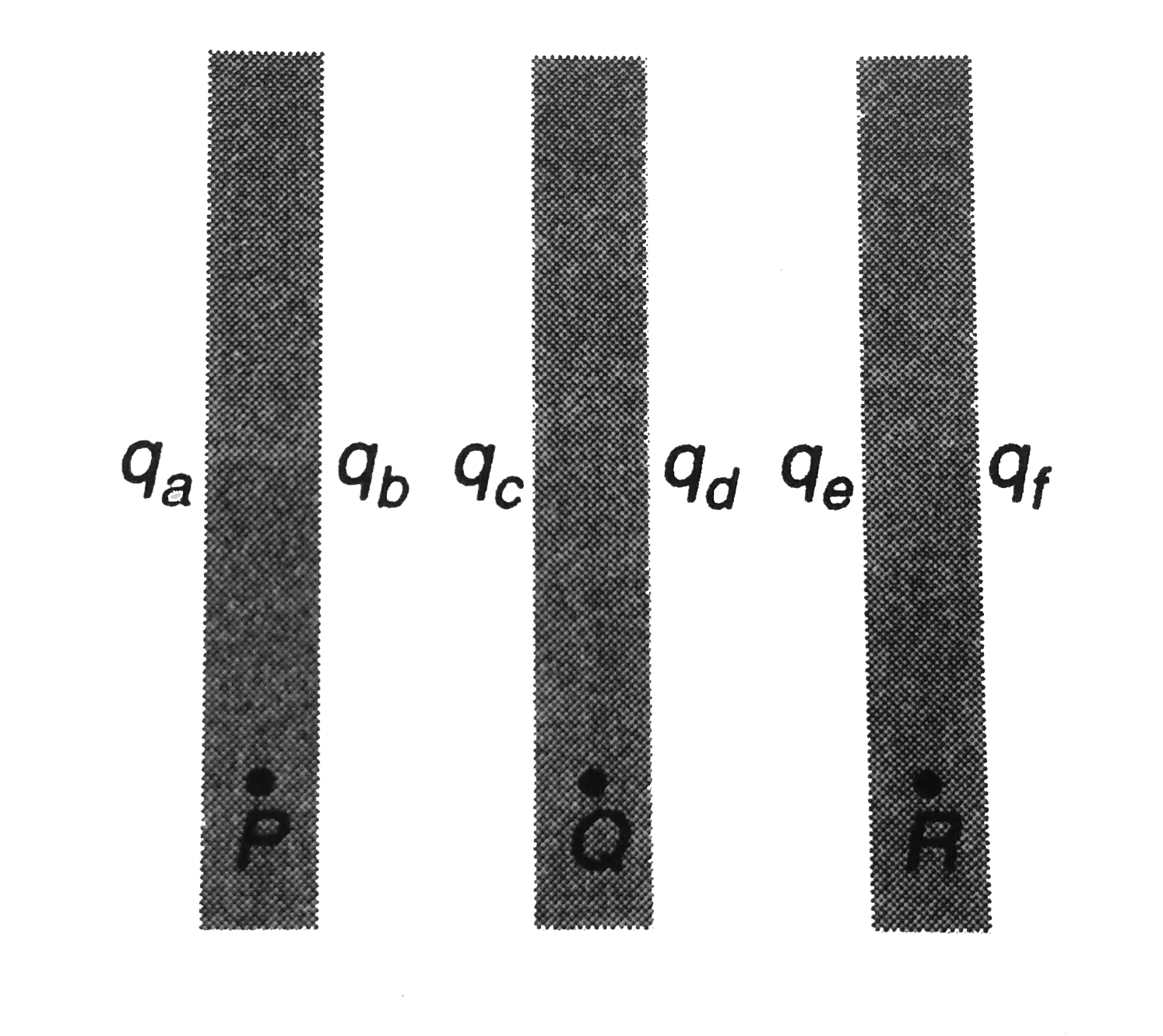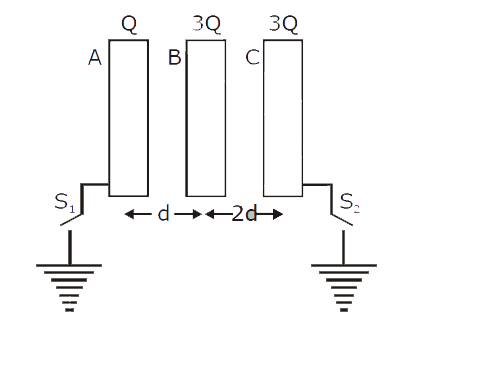Three parallel metalic plates each of area are kept as shown in figure and charges and are given to them. Find the resulting charge distribution on the six surfaces, neglecting edge effects as usual,

The plate separations do not affect the distribution of charge in this problem.
In the figure
electric field at point P is zero because this point is lying inside a conductor.

At charge will give an electric field towards right. All other charges .........etc. will give electric field towars left. So,
or
or
similarly the conditionn
will give the result
from here we may conclude that half of the sum of all charges appears on each of the two outermost surfaces of the system of plates.
Further we have a condition.
or
similarly, we can show that
from here we can find another important resultant that the pairs of opposite surfaces like , and carry equal and opposite charges.
Topper's Solved these Questions
- CAPACITORSBook:DC PANDEYChapter:CAPACITORSExercise:Exercise
Explore 155 Videos
- CAPACITORSBook:DC PANDEYChapter:CAPACITORSExercise:OBJECTIVE_TYPE
Explore 1 Video
- ATOMSBook:DC PANDEYChapter:ATOMSExercise:MEDICAL ENTRANCES GALLERY
Explore 42 Videos
- COMMUNICATION SYSTEMBook:DC PANDEYChapter:COMMUNICATION SYSTEMExercise:Subjective
Explore 11 Videos
Similar Questions
Three identical metallic plates, each of area A, are kept at small separations as shown. Initially, charge Q, 3Q and 3Q are given to the plates A, B and c, respectively. Now, both the switches S1 and S2 are closed simultaneously. Then Charge flown through S1 and S2 are

View SolutionTwo metallic plates are kept parallel to one another and charges are given to them as shown in figure. Find the charge on all the four faces.

View Solution
Knowledge Check
The value of charge q1,q2andq3 as shown in the figure are
 Aq1=32μC,q2=24μC,q3=−8μCBq1=48μc,q2=16μC,q3=+8μCCq1=32μC,q2=24μC,q3=+8μCDq1=3μC,q2=4μC,q3=+2μC
Aq1=32μC,q2=24μC,q3=−8μCBq1=48μc,q2=16μC,q3=+8μCCq1=32μC,q2=24μC,q3=+8μCDq1=3μC,q2=4μC,q3=+2μCThree very large plate are given charges as shown in the figure, if the cross -sectional area of each plate is the same the final charge distribution on plate C is
 A+5Q on the linear surface ,+5Q on the outer surfaceB+6Q on the inner surface ,+4Q on the outer surfaceC+7Q on the inner surface ,+3Q on the outer surfaceD+8Q on the inner surface ,+2Q on the outer surface
A+5Q on the linear surface ,+5Q on the outer surfaceB+6Q on the inner surface ,+4Q on the outer surfaceC+7Q on the inner surface ,+3Q on the outer surfaceD+8Q on the inner surface ,+2Q on the outer surfaceThree identical conducting plain parallel plates, each of area A are held with equal (/ between successive surfaces. Charges 2Q, and 3Q are placed on them. Neglecting edge effects, find the Charge on the left face of the middle plate
A0B2QC3QDNone of the Above
Two conducting plates A and B are placed parallel to each other. A is given a charge. Q1 and B a charge Q2. Find the distribution of charges on the four surface.
View SolutionSome isolated metal plates with large surface areas are kept parallel to each other and total charges on each plate are as shown. Find the charge appearing on the surfaces of plates.
(a)
View SolutionThe three small spheres as shown in figure carry charges q1=4nC,q2=−7.8nCandq3=2.4nC. Find the net electic flux through each of the following closed surfaces shown in cross section in the figure.
a. S1 b.S2
c. S3 d. S4
e. S5.
Do your answers to parts from (a) to (e) depend on how the charge is distributed over each small sphere? Why or why not?
 .
.
View SolutionThree identical metal square plates of surface area A of each side is arranged as shown in the figure.Plates 1 2 and 3 are given charges +20, -Q and -Q respectively. Find out the correct options A) Charge on the two faces of the middle plate are -2Q and Q B) Charge on the two faces of the middle plate are -Q and 0 C) Charge on the two faces of the left most plate are zero and 2Q D) Charge on the two faces of the right most plate are -Q and zero
View SolutionThree charges −q1, +q2 and −q3 are placed as shown in the figure. The x-component of the force on −q1 is proportional to

View Solution